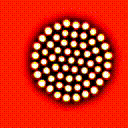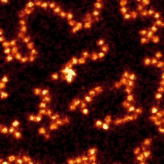Active Colloids: Novel Mesophases and Devices
Swimmers and self-propelled particles are physical models for the collective behaviour and motility of a wide variety of living systems, such as bacteria colonies, bird flocks and fish schools. Such artificial active materials are amenable to physical models which reveal the microscopic mechanisms underlying the collective behaviour. Here we study colloids in a DC electric field. Our quasi-two-dimensional system of electrically-driven particles exhibits a rich and exotic phase behaviour. At low field strengths, electrohydrodynamic flows lead to self-organisation into crystallites with hexagonal order. Upon self-propulsion of the particles due to Quincke rotation, we find an ordered phase of active matter in which the motile crystallites constantly change shape and collide with one another. At higher field strengths, this "dissolves" to an active gas. We parameterise a particulate simulation model which reproduces the experimentally observed phases and, at higher field strengths predicts an activity-driven demixing to band-like structures.

Phase Behaviour of the Quicke Rollers
A: The illustration of a Quincke rollers.
B: The design of the 2D system.
C: The phase behavours of the active system.
Active matter also provides a route towards novel devices. We have already demonstrated torque control at the colloidal scale using optical tweezers to drive a colloidal "gearwheel". Our experiments with the Quincke rollers suggests that this circular motion can be accelerated by some 10,000 times. Harnessing active matter has huge untapped potential, and that the electric field-driven Quincke rollers are an ideal model system for prototyping active machines at small lengthscales.

Self-assembled Active rotor of Quincke Rollers. Movie is slowed down 10 times.
Active Colloids in 3d
Active colloids in 3d are exceedingly rare, most systems are quasi 2d sedimented onto a substrate. We have taken a Janus particle system, exhibiting induced charge electrophoresis, which is active in the xy plane. The strong dipolar interactions in the z direction lead to the formation of a number of (colloidal) polymorphs, while at lower volume fraction novel sheet-like and labyrinthine structures form. Powered by the external AC electric field, these structures are reminiscent of membranes in living systems.

Active Labyrinth phase form of 1.5 micron Janus Particles.